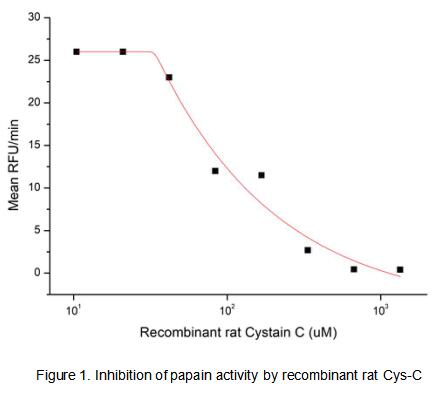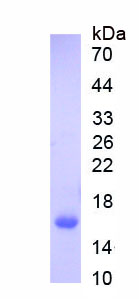Active Cystatin C (Cys-C) 

CST3; Cystatin 3; Gamma Trace; Post-Gamma-Globulin; Neuroendocrine Basic Polypeptide; Amyloid Angiopathy And Cerebral Hemorrhage
- UOM
- FOB US$ 372.00 US$ 930.00 US$ 1,860.00 US$ 5,580.00 US$ 13,950.00
- Quantity
Overview
Properties
- Product No.APA896Ra61
- Organism SpeciesRattus norvegicus (Rat) Same name, Different species.
- ApplicationsCell culture; Activity Assays.
Research use only - DownloadInstruction Manual
- CategoryKidney biomarker
- Buffer FormulationPBS, pH7.4, containing 5% Trehalose.
- Traits Freeze-dried powder, Purity > 90%
- Isoelectric Point9.2
Sign into your account
Share a new citation as an author
Upload your experimental result
Review

Contact us
Please fill in the blank.
Activity test

Cystatin C is a member of family 2 of the Cystatin superfamily. It is involved in processes such as tumor invasion and metastasis, inflammation and some neurological diseases. It inhibits many cysteine proteases such as papain and cathepsins B, H, K, L and S. It is ubiquitous in human tissues and body fluids. A point mutation in the gene coding for the 120 amino acid mature Cystatin C causes a hereditary form of amyloid angiopathy in which the protein variant (Leu68 to Gln) is deposited in the cerebral arteries, leading to fatal cerebral hemorrhage. Cystatin C may have additional clinical applications. For example, it is a good marker for glomerular filtration rate. The activity of recombinant rat Cystatin C was measured by its ability to inhibit papain cleavage of a fluorogenic peptide substrate Z-FR-AMC in the assay buffer 50 mM Tris, pH 7.0. Papain was diluted to 500 ug/ml in activation buffer 50 mM Tris, 5 mM DTT, pH 7.0 and incubated at room temperature for 15 minutes. The activated papain was diluted to 100 ug/ml in the assay buffer and 20 ul different concentrations of recombinant rat Cystatin C (MW: 14.93 KD) was incubated with 20 ul 100 ug/ml papain at 37 ℃ for 10 minutes. Loading 50 µL of the incubated mixtures which were diluted five-fold in assay buffer into empty wells of a plate, and start the reaction by adding 50 µL of 200 µM substrate. Include a substrate blank containing 50 µL of assay buffer and 50 µL of 200 µM substrate. Then read at excitiation and emission wavelengths of 380 nm and 460 nm, respectively, in kinetic mode for 5 minutes. The result was shown in Figure 1 and it was obvious that recombinant rat Cystatin C significantly decreased papain activity. The inhibition IC50 was <80 nM.
Usage
Reconstitute in 10mM PBS (pH7.4) to a concentration of 0.1-1.0 mg/mL. Do not vortex.
Storage
Avoid repeated freeze/thaw cycles. Store at 2-8°C for one month. Aliquot and store at -80°C for 12 months.
Stability
The thermal stability is described by the loss rate. The loss rate was determined by accelerated thermal degradation test, that is, incubate the protein at 37°C for 48h, and no obvious degradation and precipitation were observed. The loss rate is less than 5% within the expiration date under appropriate storage condition.
Increment services
-
 BCA Protein Quantification Kit
BCA Protein Quantification Kit
-
 Molecular Mass Marker for Protein
Molecular Mass Marker for Protein
-
 Monoclonal Antibody Customized Service
Monoclonal Antibody Customized Service
-
 Polyclonal Antibody Customized Service
Polyclonal Antibody Customized Service
-
 Protein Activity Test Experiment Service
Protein Activity Test Experiment Service
-
 Electrophoretic Mobility Shift Assay (EMSA) Experiment Service
Electrophoretic Mobility Shift Assay (EMSA) Experiment Service
-
 Buffer
Buffer
-
 Lentivirus Packaging Experiment Service
Lentivirus Packaging Experiment Service
-
 Adenovirus Packaging Experiment Service
Adenovirus Packaging Experiment Service
-
 Real Time PCR Experimental Service
Real Time PCR Experimental Service
-
 Spike RBD Protein (S-RBD)
Spike RBD Protein (S-RBD)
-
 Protein G
Protein G
-
 Protein A
Protein A
Citations
- The Renal Effects of Vanadate Exposure: Potential Biomarkers and Oxidative Stress as a Mechanism of Functional Renal Disorders—Preliminary StudiesHindawi: 740105
- Endothelial dysfunction and renal fibrosis in endotoxemia-induced oliguric kidney injury: possible role of LPS-binding proteinPubmed:25261195
- РОЛЬ АПОПТОЗ ИНДУЦИРУЮЩЕГО ФАКТОРА И ОКИСЛИТЕЛЬНОГО СТРЕССА ПРИ ХРОНИЧЕСКОЙ СЕРДЕЧНОЙ НЕДОСТАТОЧНОСТИ616-005.8
- Protective Effects of DHA-PC against Vancomycin-Induced Nephrotoxicity through the Inhibition of Oxidative Stress and Apoptosis in BALB/c Micepubmed:29254330
- Association of cathepsin B and cystatin C with an age-related pulmonary subclinical state in a healthy Chinese populationPubmed: 32401159
- SERS based Y-shaped aptasensor for early diagnosis of acute kidney injuryPubmed:35733690
- A Compared Study of Gentle Ketogenic Diet Containing Medium-Chain Triglycerides or Long-Chain Triglycerides on Chronic Sleep Deprivation-Induced Cognitive …Pubmed:35141738







